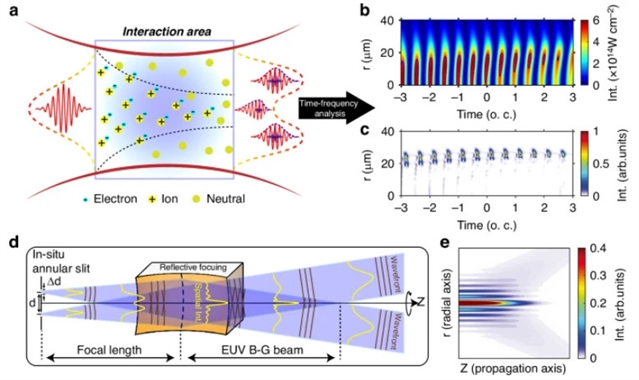
吉林大学丁大军团队实现了通过非绝热相位匹配的高次谐波高效生成贝塞尔-高斯阿秒脉冲串。这一研究成果于2025年5月6日发表在《光:科学与应用》杂志上。
由于传统传输光学元件的局限性,在极紫外(EUV)中产生阿秒脉冲持续时间的贝塞尔-高斯光束是一个重大挑战。研究组提出了一种在非绝热相位匹配条件下通过高次谐波产生(HHG)诱导环形EUV源来产生这种光束的新方法。由此产生的光脉冲保持时间相干性,并表现出阿秒脉冲串,这一点通过双光子跃迁干涉(RABBIT)测量重建阿秒拍频得到了证实。
宏观HHG计算再现了测量的时空结构,证明了等离子体对环形源形成的空间调制。传播模拟进一步证实了这种方法产生阿秒贝塞尔-高斯光束的可行性,为EUV光子学和阿秒科学的各种应用带来了令人兴奋的前景。
附:英文原文
Title: Efficient generation of Bessel-Gauss attosecond pulse trains via nonadiabatic phase-matched high-order harmonics
Author: Li, Mingxuan, Tang, Xiangyu, Wang, Huiyong, Li, Jialong, Wang, Wentao, Cai, Jiaao, Zhang, Jieda, San, Xinyue, Zhao, Xinning, Ma, Pan, Luo, Sizuo, Jin, Cheng, Ding, Dajun
Issue&Volume: 2025-05-06
Abstract: Generating Bessel-Gauss beams in the extreme ultraviolet (EUV) with attosecond pulse durations poses a significant challenge due to the limitations of conventional transmission optical components. Here, we propose a novel approach to produce such beams by inducing an annular EUV source through high-order harmonic generation (HHG) under nonadiabatic phase-matching conditions. The resulting light pulse maintains temporal coherence and manifests attosecond pulse trains as confirmed by the reconstruction of attosecond beating by interference of two-photon transitions (RABBIT) measurements. Macroscopic HHG calculations reproduce the measured spatiotemporal structures, demonstrating the plasma-induced spatial modulation on the formation of an annular source. Propagation simulations further confirm the feasibility of this approach for generating attosecond Bessel-Gauss beams, presenting exciting prospects for various applications in EUV photonics and attosecond science.
DOI: 10.1038/s41377-025-01845-7
Source: https://www.nature.com/articles/s41377-025-01845-7
Light: Science & Applications:《光:科学与应用》,创刊于2012年。隶属于施普林格·自然出版集团,最新IF:19.4
官方网址:https://www.nature.com/lsa/
投稿链接:https://mts-lsa.nature.com/cgi-bin/main.plex
